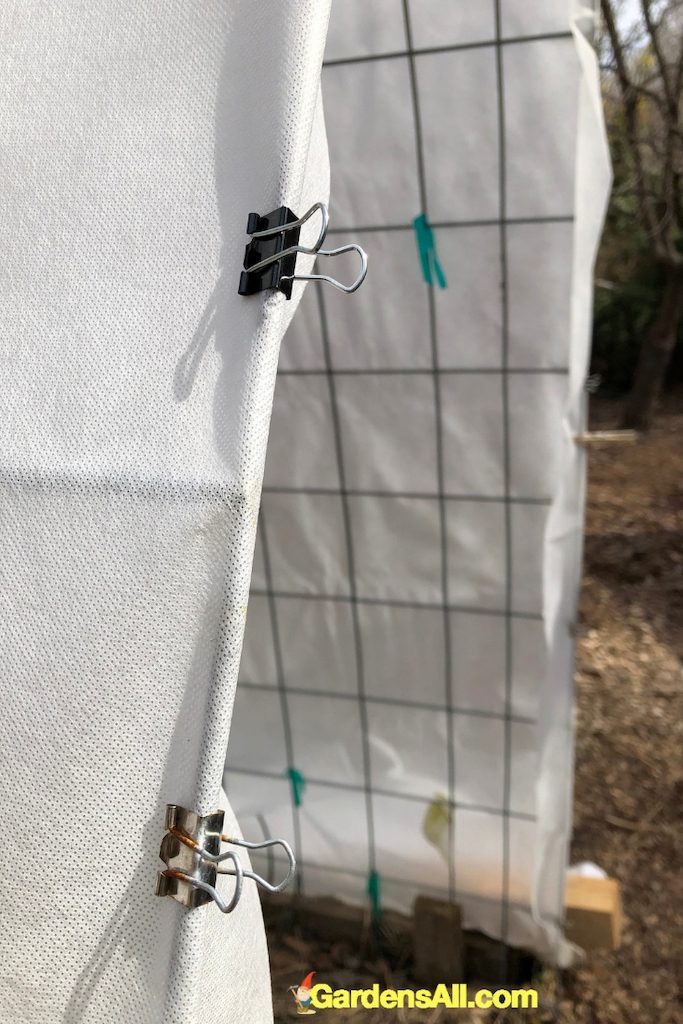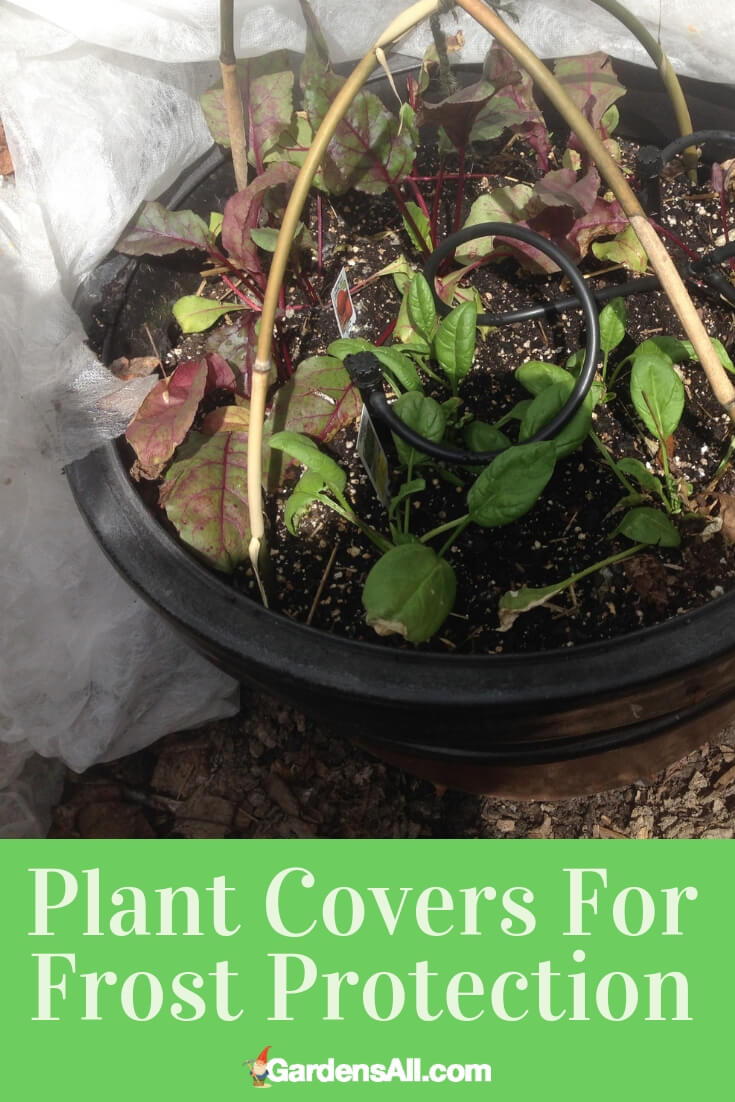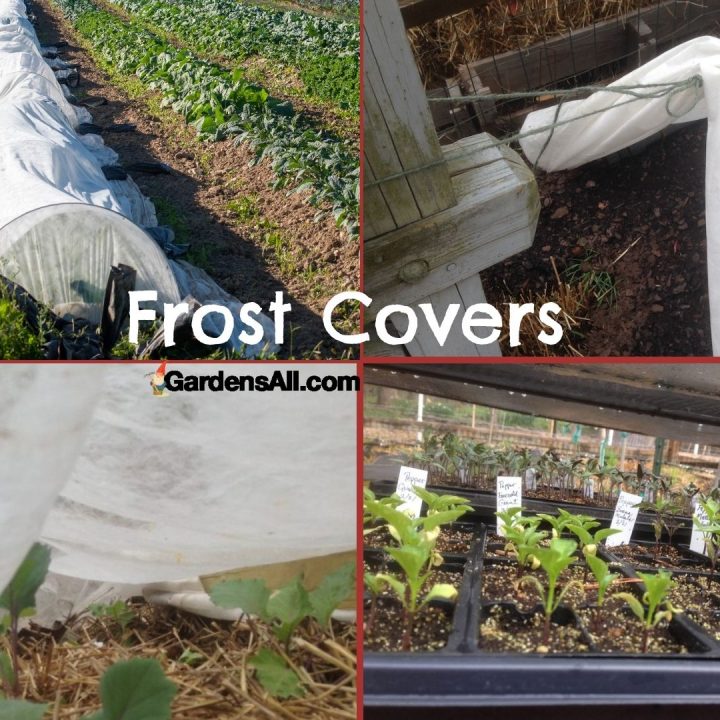As soon as the first local “Frost Alert” has been issued and it looks like our more tender crops will be taken out by Mr. Jack, we get out the frost covers to keep our fall and winter crops growing.
Living here in the western Piedmont of North Carolina, we have the fortune of gardening well into fall. What expands our growing season, even through winter, are simple plant covers or row covers for frost protection.
Into late fall, we still have a bumper crop (for our little space) of sweet peppers and Japanese eggplant bushes yielding their last for the season. Meanwhile, our collection of winter vegetables and greens are perky and happy growing under the frost covers.
What Temperature Is Frost?
You can have frost above the freeze line of 32°F / 0°C.
Our observations regarding frost indicate it’s not just the temperature. Temps can be as high as 38 to 41 degrees and we’ll get patchy frost.
At times when the temps approach freezing, there will be little to no frost. Conditions such as clear skies, little to no wind, a down hill (lower) elevation, and soil moisture all have an impact. From 38 degrees down to just above 32 degrees, chances of frost increase. Of course, from 32 degrees and below it’s frost/freeze territory. [1]https://www.weather.gov/arx/why_frost
These first few cold snaps usually prompt us to layout frost blankets that will stretch the growing season just a little more. Before we delve into frost protection, let’s consider a few resources that can guide our decisions as to when and how we begin to extend our growing season.
If you’re in the colder more snowy growing zones with lots of snow, frost covers may not work as well, but you could try using the heavier frost blankets to extend as much as possible.
Your Plant Hardiness Zone
Eventually, we just have to roll with the seasons. North Carolina has plant hardiness zones ranging from 8B in the Coastal plain down to 5B in the mountains. We happen to be in Zone 7A. Of course, these are averages, but you get a general picture. It’s like gambling with the USDA as your odds maker. Plant sellers and customers who follow the Hardiness Zone Maps and assume “normal” temps will prevail are essentially gambling.
Back in the early 80’s, while working in the Asheville area as a landscaper, a severe cold snap killed off a slew of hollies. The Burford hollies (Ilex cornuta) were decimated. Rated as hardy within Zones 7 to 9, the Burfords had been planted for decades around many of the stately homes we serviced. Some had grown to be like small trees.
We spent most of that spring and early summer, removing the dead hollies and replacing them with hardier plants. It was a bust for many homeowners, but a boon for our company.
The object lesson here is to know the risks of assuming normal. We suggest selection of plants based on a margin of safety-at least a zone lower, if not two. We take a chance on a Zone 7A plants now and then, but are much more comfortable with 6A.
For a more specific hardiness map of your location there are USDA maps that can be zeroed in via zip code. These local maps take into account elevations. Usually, the higher the elevation the colder the zone. Hence, our upper garden is likely more like a 6B since it’s at a higher elevation and close to Pilot Mountain State Park.
Finding Frost Temperature for Your Area
We remind ourselves occasionally that the Ag Zones don’t specify frost dates. For that info, we go to the NOAA for state by state climate data.
You can look up frost and freeze data on their home page by clicking on your state and then finding the closest town/city/airport that is collecting data. There you’ll find projected dates of last and first frosts and freezes. Only this time, they’re more specific. Below is a section on North Carolina.

For our own area (near the Greensboro Airport), we see that the first frost date is pretty accurate. The weather forecasts a potential first frost on October 22.

Plant Covers
Once we have an idea of upcoming weather conditions, we’re better informed on when to start using plant covers to extend our growing season. A proven method is the use of various thicknesses of frost cloth.
These covers don’t just keep the cold from intruding. They also keep the ambient warmth from radiating outward. In this way, garden row covers are like cloud cover that interferes with the earth’s heat radiating into space. Laser thermometer measurements indicate a cover can conserve as much as 12 degrees more heat.
We borrowed this chart from a maker of agricultural row covers to illustrate the types of coverage and frost protection. The more weighty the fabric, the more protection but also the less light transmission. Weather conditions permitting, consider using your heavier fabrics mainly overnight and leaving the crops open to sun during the day.
Frost Cover Chart
Here’s a handy chart from the AgFabric folks that can help you determine the level of protection and how it affects light transmission. .

Frost Blankets vs. Floating Row Covers
What’s the difference between the two? Frost blankets are thicker and serve more specifically to help keep the plants warmer. Floating row covers are thinner and lighter weight, and while they also keep the frost off, they can be used during the day for growing under as well.
Floating Row Covers
Floating row covers are rather gauzy materials that are often used for barriers against insects. They are lightweight enough to rest directly on the plant without damage.
On our fall crops, we already have one layer. With the onset of “Frost Alerts”, we add an additional layer of the same lightweight fabric.
We prefer to tent ours over a taut string or wire. Then, we pin the sides with landscape staples. The ends can be closed off with clothespins or metal binder clips.
Metal hoops, sold by on-line row cover suppliers, can be used to create a floating row tunnel. There are also various pre-fab tunnels that offer varying levels of frost protection.



Single Plant Covers for Potted Plants, Shrubs and Bushes
Here, we have spinach growing in a pot with a bamboo arch to support a plant cover. Spinach can take temperatures below freezing but we don’t want to push our luck, so we cover it with plant covers whenever there’s threat of frost.

Frost Blankets
For heavier covers in colder temperatures, use the heavier blankets, layered or alone, depending on the chart calculations for your temps. With frost blankets we can grow cole crops throughout winter in zone 7a.
An upgrade of plant protection for winter, we’ve used frost blankets successfully now for several years. Row covers have been particularly useful over crops like broccoli, collards, carrots, Bok Choy, spinach and Swiss chard.

Frost Blankets Over Cattle Panel Arches
We’ve also deployed frost blankets over cattle panel arches as a kind of stand-up cold frame. This served as a sort of greenhouse that allows for harvesting arugula all winter long.

Tips for Using Frost Blankets
A few pointers about these heavier fabrics. They do have weight and it’s better to use wire hoops, bamboo, PVC pipe, or conduit pipe as a support. Your tents and tunnels will also need to stand up to the wind and snow.
If you can engineer a way to easily remove and replace the frost cover, all the better for allowing the plants to soak up the sun on warmer days. This removable feature will also allow you to check plants for any problems and to harvest.

Early Spring Planting Possible With Plant Covers
Here in Zone 7A (NC), the temperatures vary widely. We enjoy the variety and the many mild winter reprieves. With plant covers we were able to start the growing season way early for our squash plants which were planted the second week of April.
The tender squash will be covered with frost blankets when temps drop.
It’s simple to set up a protected row by driving tall stakes at either end of your bed and run a line between them to drape the cloth over. Then pin the edges down securely. We like the long landscape fabric staples for pinning. Store bought tunnel systems like this Easy Tunnel work well also.
If you want to go with a bigger tunnel, you may enjoy reading about vertical gardening ideas and also the cattle panel greenhouse option.
Frost Covers Over Straw Bale Raised Garden Beds
Our first batch of straw bales is done curing and the bales have turned soft and mushy inside. Warm too. Find info the warm temps benefits of straw bale gardening here. These will host the kale, spinach, radishes, and, once temps stay mostly in the 50’s, we’ll plant the first batches of lettuce and tomatoes.
Speaking of radishes, this year we’re growing a fast-maturing variety, Radish Saxa II. It will be allow a smaller period between intervals before the temps get too warm (65 degrees and above consistently). Radishes will bolt and fail to form bulbs in warm temps.

Seedling Flats
Our flats of seedlings are all enjoying the spring weather when it happens. They’ve had a few overnights under frost covers as well when the low temps remained above 50 degrees.
If temps drop below the 50°F mark, we bring all of the flats into the cattle panel greenhouse or else the indoor greenhouse rack for protection. Tomatoes are particularly sensitive.

Early Spring Crops to Grow Under Plant Covers
We planted kohlrabi transplants in the dirt yesterday. Two heirloom types, purple and white, went in on either side of the cloth house. Since the collards did so well in the same spots, we’ll try the kohlrabi, which are closely related.
Frost Covers Protect Against Garden Pests
We’ve started keeping the lighter frost covers over our cabbage plants even beyond threat of frost to help with pest control. We discovered that the floating row covers serve as a barrier against cabbage worms and loopers.


Row Cover Frames
For support of the frost cover fabrics we use a variety of row cover frames:
- Jute twine strung between posts – tent style
- Hoops – store bought or homemade
- PVC pipe
- Bamboo
- Stout fencing wire
Twine
The simplest row cover frame is a doubled length of jute twine stretched between two posts. The cover drapes over like a tent and the edges are pinned with landscape fabric “staples”.
It’s fairly easy to adjust the height over a single row, and easy to unpin one side to uncover for warmer days, cultivation, or harvest. It’s not so good with snow cover or taller plants, and the twine does stretch, so you’ll want to tie it in a slip knot so as to easily tighten it as needed.

Hoops
The next method uses hoops, either store bought or home made designs made of pvc pipe, bamboo, or stout fencing wire. The best way we found to attach fabric to the wire is using document binder clips from the office.
Our stoutest supports are made from concrete reinforcement wire and cattle panels. The latter can also be shaped into stand-up cold frames and covered in poly.

It’s best if you can design covers so they can be handily removed for the occasional warm sunny day, to tend your crops, and for easier harvesting. Of course, climates and wind velocities can vary widely so having ample anchorage to keep the fabric pinned down is also important.

Extend Your Growing Season
The use of row covers and support frames not only protects winter garden plants, but can get your spring garden going much earlier. An extended growing season means extended harvests, and in some zones—even some of the wintery ones—that can mean year round growing!
Winter Landscape Plants
One bright spot in our winter landscape is this wonderful Arnold’s Promise witch hazel tree.
The frilly, lightly scented blossoms are a “promise” of a new season of life bursting forth. Meanwhile, we shall enjoy the weather with its ebbs and flows.
For 30 years, our Arnold’s Promise witch hazel tree has bloomed every February like clockwork.
~GardensAll.com

Let us Know
We appreciate sharing our experiences and ideas with our fellow garden enthusiasts, and hearing yours!
If you have anything to share about the topic of winter gardening, you are most welcome to post on our Facebook page or send us a message. We’d be glad to publish your experience and photos on this or other garden related topics.
Tips and Hacks
In this video, Coleman talks about the kinds of frost covers for plants that we’re using, including the various support structures we’ve rigged up for it.
We are eager to hear what’s up in your garden (or garden planning and indoor seedlings). Please, feel free to send us an email or comment on our Facebook page.
Grow well and harvest aplenty!
Coleman for GardensAll

Making the Most of Weather
Folks everywhere are seeing unusual weather patterns. In some places it’s bad news and in others it’s actually an improvement. But the earth has been going through freezing and heating for billions of years, so the best thing is to make the most out of what you have using the tools available.
Like the funny picture of the lady out in her snowy garden with the caption, “Screw it, I’m gardening!” We are too! So like the weather, we’ve jumped into spring fever early with a bit of help from frost blankets and row covers.

Whether you call them frost covers, row covers, or frost blankets, plant covers are a simple and effective tool to extend your growing season.
We are always eager to hear from our fellow garden enthusiasts. Let us know what you’ve been doing to extend your growing season. We’re especially keen to hear about your take on plant covers. Comments, photos, references are all welcome on our Facebook page or by email.

G. Coleman Alderson is an entrepreneur, land manager, investor, gardener, and author of the novel, Mountain Whispers: Days Without Sun. Coleman holds an MS from Penn State where his thesis centered on horticulture, park planning, design, and maintenance. He’s a member of the Phi Kappa Phi Honor Society and a licensed building contractor for 27 years. “But nothing surpasses my 40 years of lessons from the field and garden. And in the garden, as in life, it’s always interesting because those lessons never end!” Coleman Alderson
References
| ↑1 | https://www.weather.gov/arx/why_frost |
|---|

